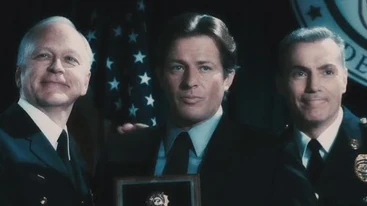| “ | I'd like to thank you all for coming today. I'd like to be the first to say the Jigsaw murders are over. The officers who gave their lives are being honored here today. | ” |
— The chief announces the end of the Jigsaw Case[src]
| ||
The Chief of Police is a fictional character from the Saw franchise as well as a minor character in Saw V. He was portrayed by Al Sapienza.
Biography[]
The Jigsaw Case[]
The Chief of Police was the leader of the Metropolitan Police Department, which was responsible for the investigation of the serial killer case of John Kramer, better known as the Jigsaw Killer. However, when John and his accomplice, Amanda Young, met their demise at the hands of Jeff Denlon, one of their victims, many of the investigating officers had died. Detective Mark Hoffman was the only surviving officer of his department, who had been a part of the investigation since the beginning. (Saw III, V)
Mark Hoffman's Promotion[]

Hoffman gets promoted
Shortly after John and Amanda's death, the chief gave a speech to the police and the press during a memorial ceremony for Hoffman as well as his deceased colleagues and thereby proudly announced that the Jigsaw killings had come to an end. Pamela Jenkins, one of the reporters, interrupted him and asked him why no representatives of the FBI were present at the memorial. The chief however, who seemed to be rather annoyed by her interruption, told her that this wasn't the time for her questions and continued his speech. Thereby, he promoted Mark Hoffman to the rank of a Detective Lieutenant and thereby handed him an honor plaque for his efforts in the case. Hoffman gave thanks to him for this honor and also gave a speech to the press as well, claiming that he and his colleagues had done their best to serve true justice. (Saw V)
Personality[]
The Chief of Police was a charismatic individual and was therefore made for his position as the leader of the police department. In the public he showed his pride for his employees and their efforts as well as the ideals that his department stood for.
Appearances and References[]
| Films | |||||||||
| Saw | Saw II | Saw III | Saw IV | Saw V | Saw VI | Saw 3D | Jigsaw | Spiral | Saw X |
| Absent | Absent | Absent | Absent | Appears | Archive | Absent | Absent | Absent | Absent |
| Other Media | |||||
| "Saw" (2003 Short) |
Saw: Rebirth (2005 Comic) |
Full Disclosure Report | The Scott Tibbs Documentary | Saw: The Video Game | Saw II: Flesh & Blood |
| Absent | Absent | Absent | Absent | Absent | Absent |
